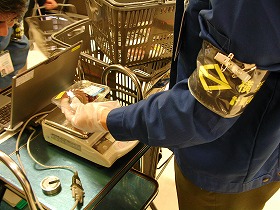- Yokohama-shi Top Page
- Living, procedures
- Housing and Living
- Consumer life
- Measurement and Inspection Offices
- On-site inspection
- On-site inspection of product quantity
The text is from here.
On-site inspection of product quantity
Last updated on March 27, 2019.
On-site inspection of product quantity
On-site inspections at supermarkets, etc.

Inspection scenery
Supermarkets sell a large number of foodstuffs. Some individual products have "weight" displayed. In order to display the appropriate weight, "use of proper measuring instruments" and "appropriate weighing" are indispensable. Maintaining "appropriate measurement" is required every day, such as horizontal installation of measuring instruments, correct tare setting, and re-measurement of products that evaporate moisture.
The Yokohama City Metrology Inspection Center conducts on-site inspections and instructs supermarkets in Yokohama City on the display of the weight of products so that consumers can purchase products with peace of mind.
Target products

Fresh fish

Meat
The on-site inspection of product quantities is performed by extracting products from "meat", "fresh fish", "vegetables", and "side dishes" that are closely related to our diet.

Fruits and vegetables

Side dish
The display of "weight" is very convenient for consumers to judge "how much they need" and "which is heavier in the same product" in their daily consumer life. . In addition, "unit price" (the value of the product based on unit price, etc.) makes it possible to compare products across departments, and it is very important that "weight" is appropriate from this point of view.
Specific products and quantity tolerances
The Measurement Law designates 29 products that should be regulated for consumer protection from among products that are likely to be weighed and sold as "specified products".
For this "specific product", the error "quantity tolerance" allowed in the display of "weight" is individually regulated.
An example of permissible error "quantity tolerance"
| Product classification | Display amount | Amount tolerance |
|---|---|---|
| Beef, pork, chicken, ham, bacon Salt Tarako, Screen, Salt Number Child Tea, coffee beans, sugar, miso | More than 100g to less than 500g | 2% |
| More than 500g to less than 1kg | 10g | |
| More than 1kg to less than 25kg | 1% | |
| Lotus root, potatoes, peas Tomato, apple, banana, takuan Tuna Sashimi, yellowtail and taragiri | More than 100g to less than 500g | 3% |
| More than 500g to less than 1.5kg | 15g | |
| More than 1.5kg to less than 10kg | 1% | |
| Soy sauce, rice vinegar, sake, whiskey Beer, mirin, kerosene, lubricating oil | More than 100ml to less than 500ml | 2% |
| More than 500ml to less than 1L | 10ml | |
| Over 1L to 25L or less | 1% |
![]() Click here for "Specific Products and Volume tolerance Application Table" (PDF: 115KB)
Click here for "Specific Products and Volume tolerance Application Table" (PDF: 115KB)
Major causes of insufficient quantity
The following causes are mainly the causes of the shortage exceeding the "quantity tolerance".
Example of insufficient quantity
| Major causes | Cases to be careful | Applicable divisions |
|---|---|---|
| Natural weight loss | Water evaporation of warm products | Side dish |
| Moisture evaporation of products with high moisture content | Fruits and vegetables | |
| Incorrect tare setting | Adding wasabi, sauce, etc. | Fresh fish |
| Change to a different tray | All divisions | |
| Changed sashimi tsuma and nakashiki | Fresh fish |
You may need a separate PDF reader to open a PDF file.
If you do not have it, you can download it free of charge from Adobe.
![]() To download Adobe Acrobat Reader DC
To download Adobe Acrobat Reader DC
Inquiries to this page
Economic Affairs Bureau, Ministry of Economy, Trade and Industry, Consumer Economy Division
Phone: 045-671-2587
Phone: 045-671-2587
Fax: 045-664-9533
E-Mail address [email protected]
Page ID: 330-302-824







